Unit 4: Management and Operations: Leadership and Management Report
VerifiedAdded on 2022/12/19
|9
|1962
|59
Report
AI Summary
This report delves into the core concepts of leadership and management, differentiating between the roles of leaders and managers within an organization. It uses Rio Tinto as a case study, examining its organizational structure and the functions of its leadership. The report explores various leadership styles, including situational, system, and contingency approaches, evaluating their strengths and weaknesses. It also analyzes the application of different management and leadership roles in scenarios such as change implementation and employee engagement, drawing on theories from Henri Fayol, Mintzberg, and situational analysis. The report concludes by summarizing the importance of selecting the appropriate leadership and management approach for organizational success and effectiveness.

Unit 4 - Management and
Operations
Operations
Paraphrase This Document
Need a fresh take? Get an instant paraphrase of this document with our AI Paraphraser

Table of Contents
INTRODUCTION...........................................................................................................................3
Introduction to Organization............................................................................................................3
Definition and Role of Leader and Manager...............................................................................3
Different roles of management and leadership in application to different organisational
situations......................................................................................................................................4
Strengths and weaknesses of different approaches to leadership and management....................6
CONCLUSION................................................................................................................................8
REFERENCES................................................................................................................................9
INTRODUCTION...........................................................................................................................3
Introduction to Organization............................................................................................................3
Definition and Role of Leader and Manager...............................................................................3
Different roles of management and leadership in application to different organisational
situations......................................................................................................................................4
Strengths and weaknesses of different approaches to leadership and management....................6
CONCLUSION................................................................................................................................8
REFERENCES................................................................................................................................9
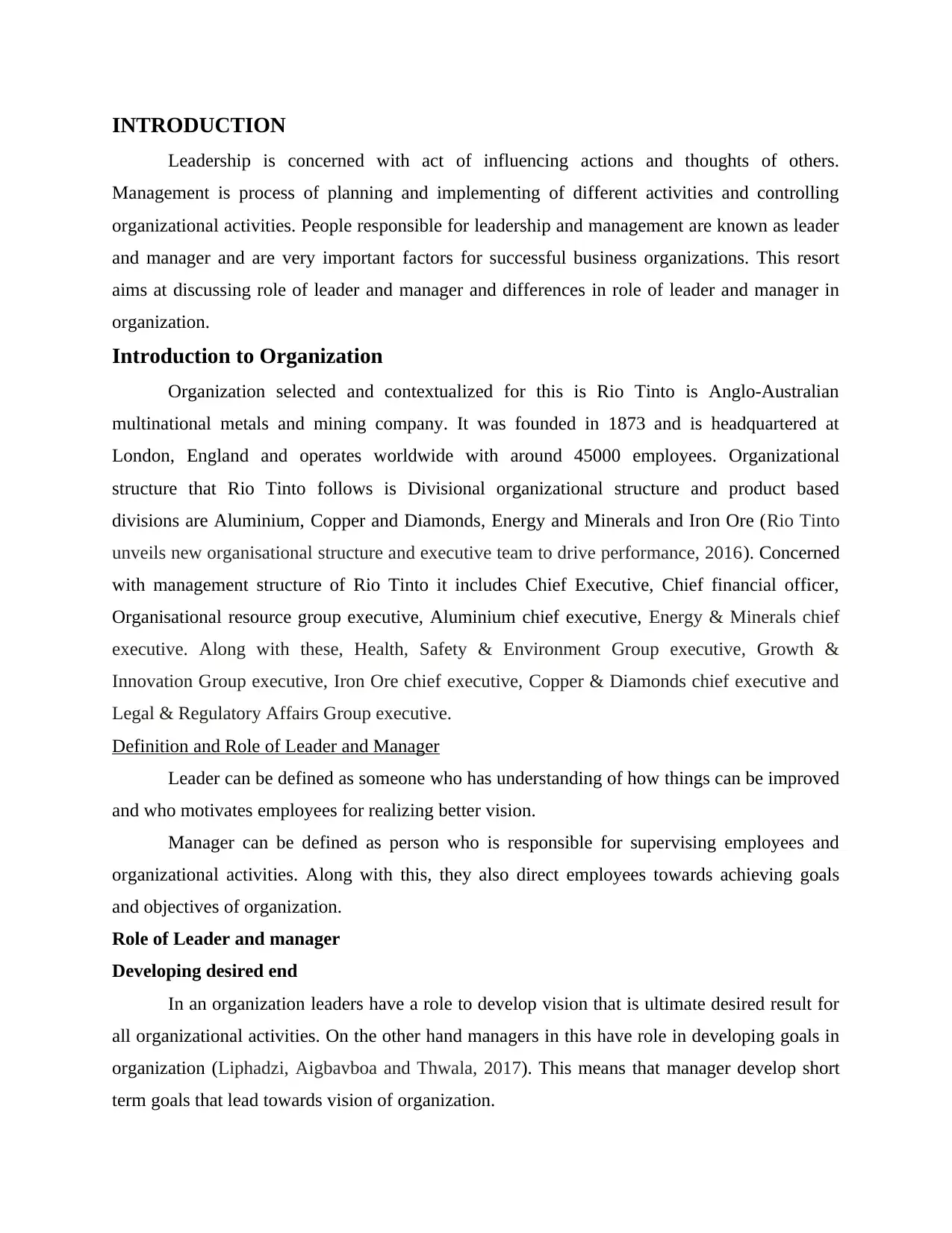
INTRODUCTION
Leadership is concerned with act of influencing actions and thoughts of others.
Management is process of planning and implementing of different activities and controlling
organizational activities. People responsible for leadership and management are known as leader
and manager and are very important factors for successful business organizations. This resort
aims at discussing role of leader and manager and differences in role of leader and manager in
organization.
Introduction to Organization
Organization selected and contextualized for this is Rio Tinto is Anglo-Australian
multinational metals and mining company. It was founded in 1873 and is headquartered at
London, England and operates worldwide with around 45000 employees. Organizational
structure that Rio Tinto follows is Divisional organizational structure and product based
divisions are Aluminium, Copper and Diamonds, Energy and Minerals and Iron Ore (Rio Tinto
unveils new organisational structure and executive team to drive performance, 2016). Concerned
with management structure of Rio Tinto it includes Chief Executive, Chief financial officer,
Organisational resource group executive, Aluminium chief executive, Energy & Minerals chief
executive. Along with these, Health, Safety & Environment Group executive, Growth &
Innovation Group executive, Iron Ore chief executive, Copper & Diamonds chief executive and
Legal & Regulatory Affairs Group executive.
Definition and Role of Leader and Manager
Leader can be defined as someone who has understanding of how things can be improved
and who motivates employees for realizing better vision.
Manager can be defined as person who is responsible for supervising employees and
organizational activities. Along with this, they also direct employees towards achieving goals
and objectives of organization.
Role of Leader and manager
Developing desired end
In an organization leaders have a role to develop vision that is ultimate desired result for
all organizational activities. On the other hand managers in this have role in developing goals in
organization (Liphadzi, Aigbavboa and Thwala, 2017). This means that manager develop short
term goals that lead towards vision of organization.
Leadership is concerned with act of influencing actions and thoughts of others.
Management is process of planning and implementing of different activities and controlling
organizational activities. People responsible for leadership and management are known as leader
and manager and are very important factors for successful business organizations. This resort
aims at discussing role of leader and manager and differences in role of leader and manager in
organization.
Introduction to Organization
Organization selected and contextualized for this is Rio Tinto is Anglo-Australian
multinational metals and mining company. It was founded in 1873 and is headquartered at
London, England and operates worldwide with around 45000 employees. Organizational
structure that Rio Tinto follows is Divisional organizational structure and product based
divisions are Aluminium, Copper and Diamonds, Energy and Minerals and Iron Ore (Rio Tinto
unveils new organisational structure and executive team to drive performance, 2016). Concerned
with management structure of Rio Tinto it includes Chief Executive, Chief financial officer,
Organisational resource group executive, Aluminium chief executive, Energy & Minerals chief
executive. Along with these, Health, Safety & Environment Group executive, Growth &
Innovation Group executive, Iron Ore chief executive, Copper & Diamonds chief executive and
Legal & Regulatory Affairs Group executive.
Definition and Role of Leader and Manager
Leader can be defined as someone who has understanding of how things can be improved
and who motivates employees for realizing better vision.
Manager can be defined as person who is responsible for supervising employees and
organizational activities. Along with this, they also direct employees towards achieving goals
and objectives of organization.
Role of Leader and manager
Developing desired end
In an organization leaders have a role to develop vision that is ultimate desired result for
all organizational activities. On the other hand managers in this have role in developing goals in
organization (Liphadzi, Aigbavboa and Thwala, 2017). This means that manager develop short
term goals that lead towards vision of organization.
⊘ This is a preview!⊘
Do you want full access?
Subscribe today to unlock all pages.

Trusted by 1+ million students worldwide
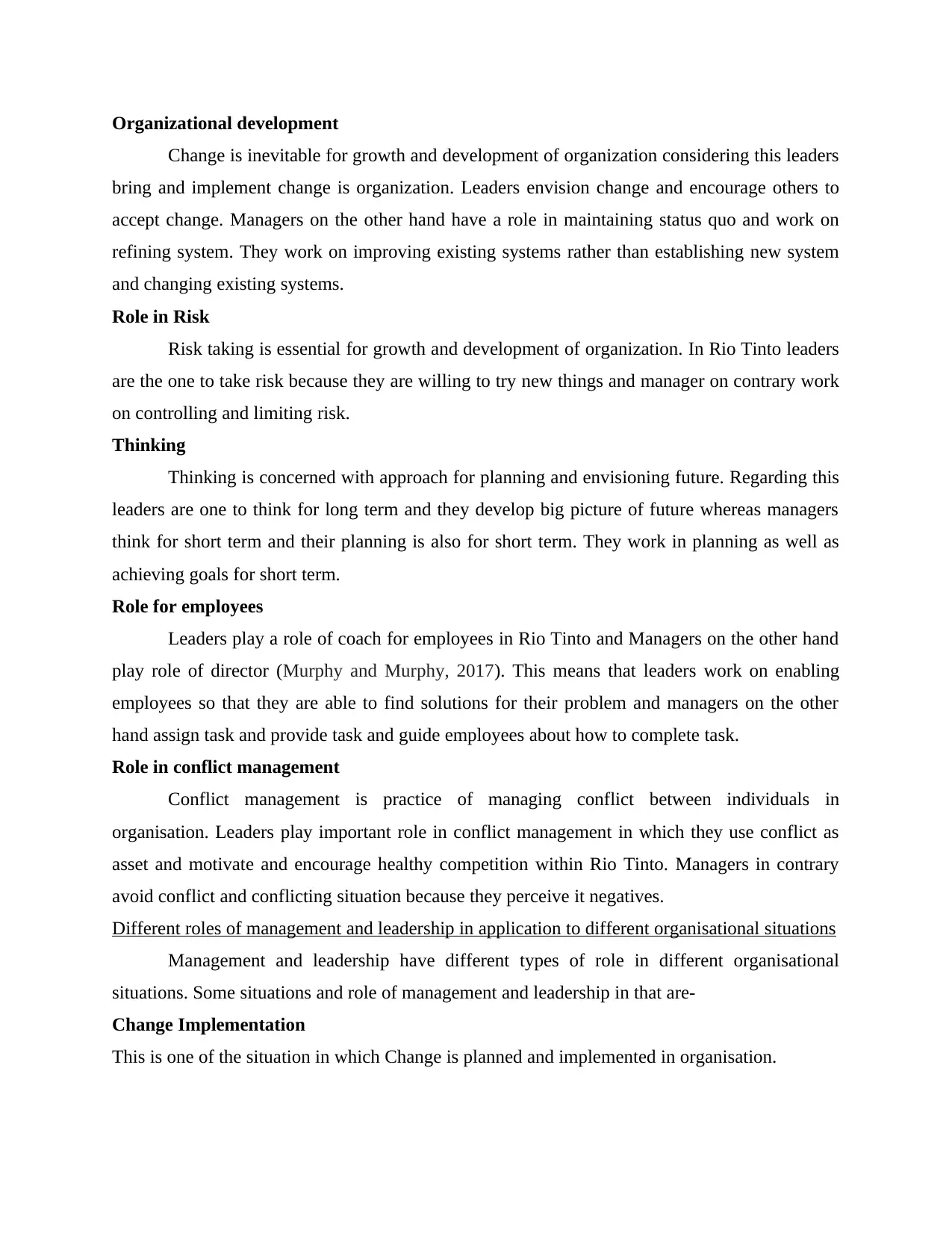
Organizational development
Change is inevitable for growth and development of organization considering this leaders
bring and implement change is organization. Leaders envision change and encourage others to
accept change. Managers on the other hand have a role in maintaining status quo and work on
refining system. They work on improving existing systems rather than establishing new system
and changing existing systems.
Role in Risk
Risk taking is essential for growth and development of organization. In Rio Tinto leaders
are the one to take risk because they are willing to try new things and manager on contrary work
on controlling and limiting risk.
Thinking
Thinking is concerned with approach for planning and envisioning future. Regarding this
leaders are one to think for long term and they develop big picture of future whereas managers
think for short term and their planning is also for short term. They work in planning as well as
achieving goals for short term.
Role for employees
Leaders play a role of coach for employees in Rio Tinto and Managers on the other hand
play role of director (Murphy and Murphy, 2017). This means that leaders work on enabling
employees so that they are able to find solutions for their problem and managers on the other
hand assign task and provide task and guide employees about how to complete task.
Role in conflict management
Conflict management is practice of managing conflict between individuals in
organisation. Leaders play important role in conflict management in which they use conflict as
asset and motivate and encourage healthy competition within Rio Tinto. Managers in contrary
avoid conflict and conflicting situation because they perceive it negatives.
Different roles of management and leadership in application to different organisational situations
Management and leadership have different types of role in different organisational
situations. Some situations and role of management and leadership in that are-
Change Implementation
This is one of the situation in which Change is planned and implemented in organisation.
Change is inevitable for growth and development of organization considering this leaders
bring and implement change is organization. Leaders envision change and encourage others to
accept change. Managers on the other hand have a role in maintaining status quo and work on
refining system. They work on improving existing systems rather than establishing new system
and changing existing systems.
Role in Risk
Risk taking is essential for growth and development of organization. In Rio Tinto leaders
are the one to take risk because they are willing to try new things and manager on contrary work
on controlling and limiting risk.
Thinking
Thinking is concerned with approach for planning and envisioning future. Regarding this
leaders are one to think for long term and they develop big picture of future whereas managers
think for short term and their planning is also for short term. They work in planning as well as
achieving goals for short term.
Role for employees
Leaders play a role of coach for employees in Rio Tinto and Managers on the other hand
play role of director (Murphy and Murphy, 2017). This means that leaders work on enabling
employees so that they are able to find solutions for their problem and managers on the other
hand assign task and provide task and guide employees about how to complete task.
Role in conflict management
Conflict management is practice of managing conflict between individuals in
organisation. Leaders play important role in conflict management in which they use conflict as
asset and motivate and encourage healthy competition within Rio Tinto. Managers in contrary
avoid conflict and conflicting situation because they perceive it negatives.
Different roles of management and leadership in application to different organisational situations
Management and leadership have different types of role in different organisational
situations. Some situations and role of management and leadership in that are-
Change Implementation
This is one of the situation in which Change is planned and implemented in organisation.
Paraphrase This Document
Need a fresh take? Get an instant paraphrase of this document with our AI Paraphraser
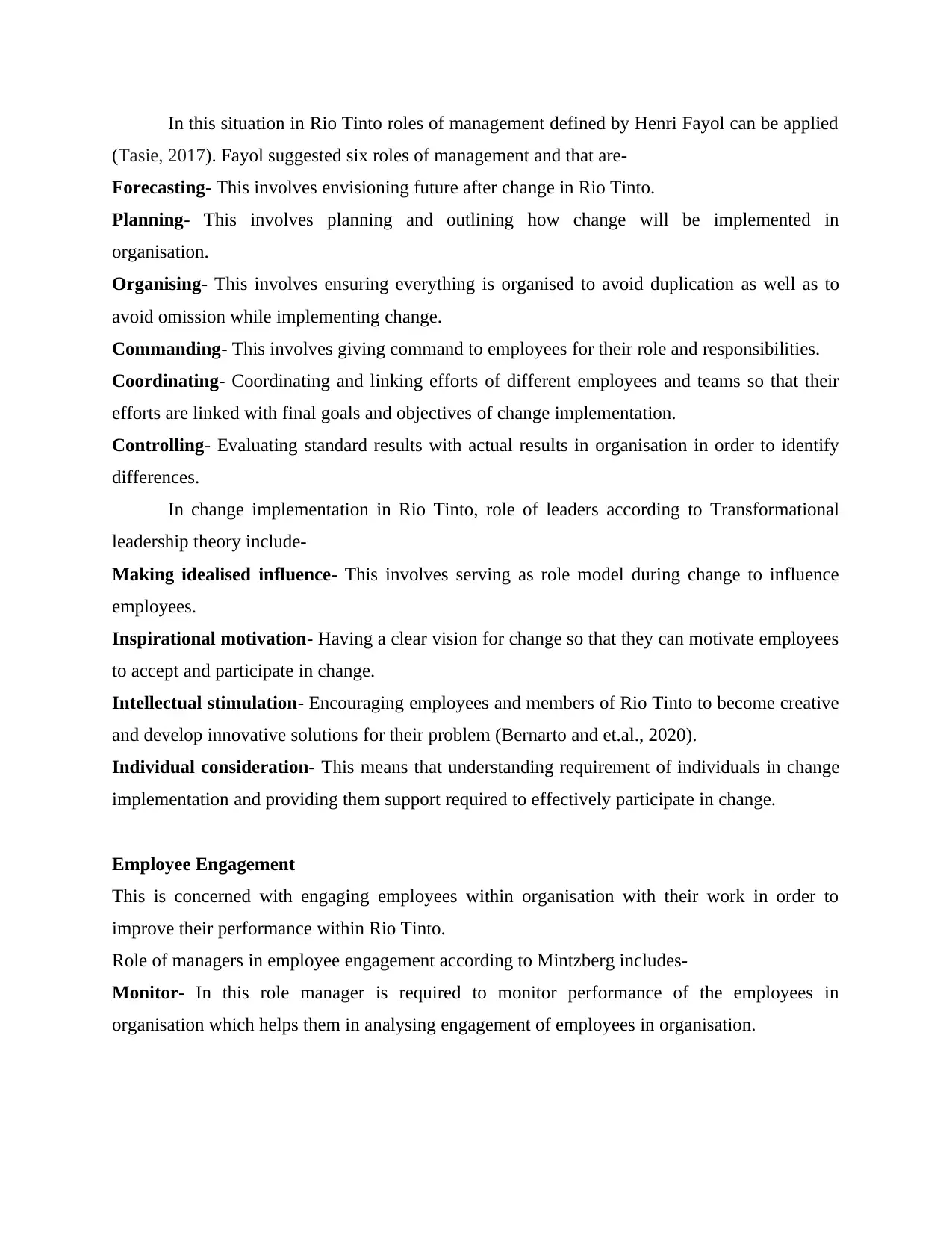
In this situation in Rio Tinto roles of management defined by Henri Fayol can be applied
(Tasie, 2017). Fayol suggested six roles of management and that are-
Forecasting- This involves envisioning future after change in Rio Tinto.
Planning- This involves planning and outlining how change will be implemented in
organisation.
Organising- This involves ensuring everything is organised to avoid duplication as well as to
avoid omission while implementing change.
Commanding- This involves giving command to employees for their role and responsibilities.
Coordinating- Coordinating and linking efforts of different employees and teams so that their
efforts are linked with final goals and objectives of change implementation.
Controlling- Evaluating standard results with actual results in organisation in order to identify
differences.
In change implementation in Rio Tinto, role of leaders according to Transformational
leadership theory include-
Making idealised influence- This involves serving as role model during change to influence
employees.
Inspirational motivation- Having a clear vision for change so that they can motivate employees
to accept and participate in change.
Intellectual stimulation- Encouraging employees and members of Rio Tinto to become creative
and develop innovative solutions for their problem (Bernarto and et.al., 2020).
Individual consideration- This means that understanding requirement of individuals in change
implementation and providing them support required to effectively participate in change.
Employee Engagement
This is concerned with engaging employees within organisation with their work in order to
improve their performance within Rio Tinto.
Role of managers in employee engagement according to Mintzberg includes-
Monitor- In this role manager is required to monitor performance of the employees in
organisation which helps them in analysing engagement of employees in organisation.
(Tasie, 2017). Fayol suggested six roles of management and that are-
Forecasting- This involves envisioning future after change in Rio Tinto.
Planning- This involves planning and outlining how change will be implemented in
organisation.
Organising- This involves ensuring everything is organised to avoid duplication as well as to
avoid omission while implementing change.
Commanding- This involves giving command to employees for their role and responsibilities.
Coordinating- Coordinating and linking efforts of different employees and teams so that their
efforts are linked with final goals and objectives of change implementation.
Controlling- Evaluating standard results with actual results in organisation in order to identify
differences.
In change implementation in Rio Tinto, role of leaders according to Transformational
leadership theory include-
Making idealised influence- This involves serving as role model during change to influence
employees.
Inspirational motivation- Having a clear vision for change so that they can motivate employees
to accept and participate in change.
Intellectual stimulation- Encouraging employees and members of Rio Tinto to become creative
and develop innovative solutions for their problem (Bernarto and et.al., 2020).
Individual consideration- This means that understanding requirement of individuals in change
implementation and providing them support required to effectively participate in change.
Employee Engagement
This is concerned with engaging employees within organisation with their work in order to
improve their performance within Rio Tinto.
Role of managers in employee engagement according to Mintzberg includes-
Monitor- In this role manager is required to monitor performance of the employees in
organisation which helps them in analysing engagement of employees in organisation.
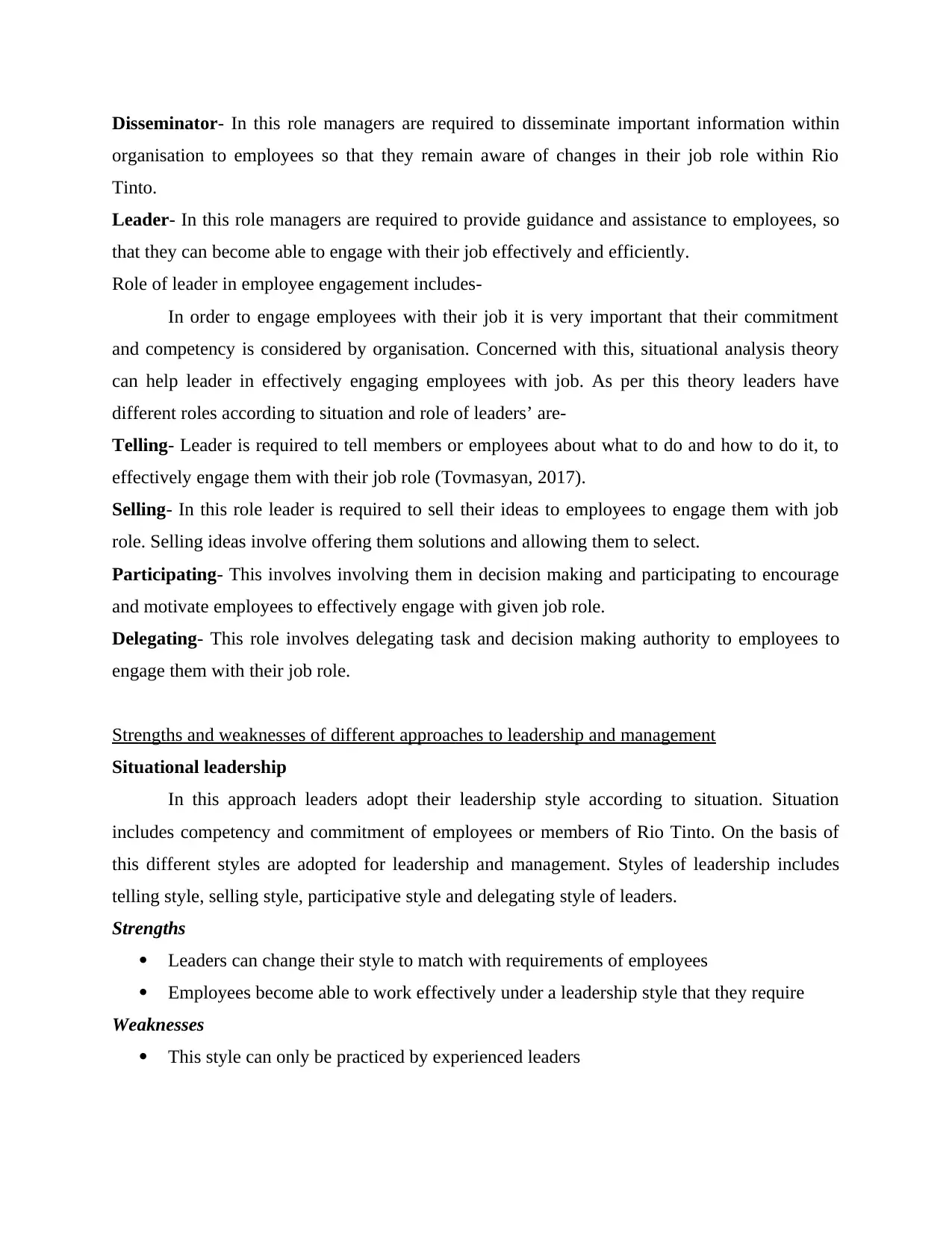
Disseminator- In this role managers are required to disseminate important information within
organisation to employees so that they remain aware of changes in their job role within Rio
Tinto.
Leader- In this role managers are required to provide guidance and assistance to employees, so
that they can become able to engage with their job effectively and efficiently.
Role of leader in employee engagement includes-
In order to engage employees with their job it is very important that their commitment
and competency is considered by organisation. Concerned with this, situational analysis theory
can help leader in effectively engaging employees with job. As per this theory leaders have
different roles according to situation and role of leaders’ are-
Telling- Leader is required to tell members or employees about what to do and how to do it, to
effectively engage them with their job role (Tovmasyan, 2017).
Selling- In this role leader is required to sell their ideas to employees to engage them with job
role. Selling ideas involve offering them solutions and allowing them to select.
Participating- This involves involving them in decision making and participating to encourage
and motivate employees to effectively engage with given job role.
Delegating- This role involves delegating task and decision making authority to employees to
engage them with their job role.
Strengths and weaknesses of different approaches to leadership and management
Situational leadership
In this approach leaders adopt their leadership style according to situation. Situation
includes competency and commitment of employees or members of Rio Tinto. On the basis of
this different styles are adopted for leadership and management. Styles of leadership includes
telling style, selling style, participative style and delegating style of leaders.
Strengths
Leaders can change their style to match with requirements of employees
Employees become able to work effectively under a leadership style that they require
Weaknesses
This style can only be practiced by experienced leaders
organisation to employees so that they remain aware of changes in their job role within Rio
Tinto.
Leader- In this role managers are required to provide guidance and assistance to employees, so
that they can become able to engage with their job effectively and efficiently.
Role of leader in employee engagement includes-
In order to engage employees with their job it is very important that their commitment
and competency is considered by organisation. Concerned with this, situational analysis theory
can help leader in effectively engaging employees with job. As per this theory leaders have
different roles according to situation and role of leaders’ are-
Telling- Leader is required to tell members or employees about what to do and how to do it, to
effectively engage them with their job role (Tovmasyan, 2017).
Selling- In this role leader is required to sell their ideas to employees to engage them with job
role. Selling ideas involve offering them solutions and allowing them to select.
Participating- This involves involving them in decision making and participating to encourage
and motivate employees to effectively engage with given job role.
Delegating- This role involves delegating task and decision making authority to employees to
engage them with their job role.
Strengths and weaknesses of different approaches to leadership and management
Situational leadership
In this approach leaders adopt their leadership style according to situation. Situation
includes competency and commitment of employees or members of Rio Tinto. On the basis of
this different styles are adopted for leadership and management. Styles of leadership includes
telling style, selling style, participative style and delegating style of leaders.
Strengths
Leaders can change their style to match with requirements of employees
Employees become able to work effectively under a leadership style that they require
Weaknesses
This style can only be practiced by experienced leaders
⊘ This is a preview!⊘
Do you want full access?
Subscribe today to unlock all pages.

Trusted by 1+ million students worldwide

Improper analysis of situation can impact effectiveness of leadership (Thompson and
Glasø, 2018).
System leadership
System leadership can be defined as approach of leadership in which all members of an
organisation participate in organisation and it’s decision-making. In this approach principles of
Human behaviour are used and these principles are used to create models of good leadership,
organisational strategy and system design.
Strengths
Increases adaptability of the organisation
Focuses on every part and dimension of organisation
Weakness
This approach of leadership is not suitable and applicable in every organisational
situation (Gilson and Agyepong, 2018).
This leadership style is not suitable in situations that require frequent solution
Contingency leadership
This is a approach of leadership and management ion which effectiveness of a particular
style is contingent upon situation. In this approach of leadership, leaders can identify their
leadership based on Least Preferred Coworker Scale. On the basis of this, mainly there are two
leadership styles, task oriented and relationship oriented style.
Strength
Dynamic nature of leadership so it can be changed according to requirement of external
situation
It provides options to employees through which they can grow and share their ideas to
business
Weakness
It is very complicated to determine their style of leadership of leaders
It is highly inflexible for leaders as they cannot change according to requirement, this
means that one style is suitable in only one situation (Inyang, Agnihotri and Munoz,
2018).
Glasø, 2018).
System leadership
System leadership can be defined as approach of leadership in which all members of an
organisation participate in organisation and it’s decision-making. In this approach principles of
Human behaviour are used and these principles are used to create models of good leadership,
organisational strategy and system design.
Strengths
Increases adaptability of the organisation
Focuses on every part and dimension of organisation
Weakness
This approach of leadership is not suitable and applicable in every organisational
situation (Gilson and Agyepong, 2018).
This leadership style is not suitable in situations that require frequent solution
Contingency leadership
This is a approach of leadership and management ion which effectiveness of a particular
style is contingent upon situation. In this approach of leadership, leaders can identify their
leadership based on Least Preferred Coworker Scale. On the basis of this, mainly there are two
leadership styles, task oriented and relationship oriented style.
Strength
Dynamic nature of leadership so it can be changed according to requirement of external
situation
It provides options to employees through which they can grow and share their ideas to
business
Weakness
It is very complicated to determine their style of leadership of leaders
It is highly inflexible for leaders as they cannot change according to requirement, this
means that one style is suitable in only one situation (Inyang, Agnihotri and Munoz,
2018).
Paraphrase This Document
Need a fresh take? Get an instant paraphrase of this document with our AI Paraphraser
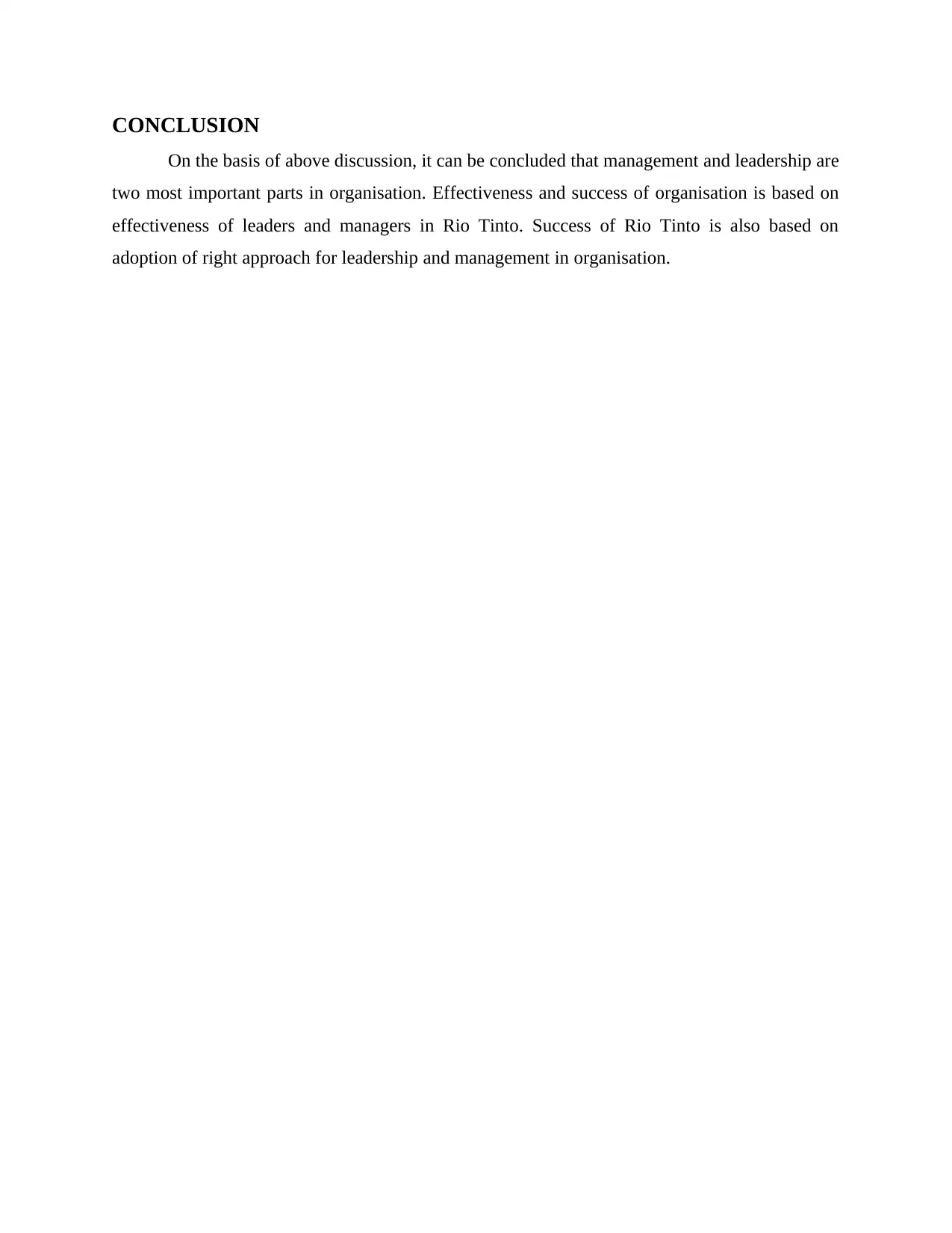
CONCLUSION
On the basis of above discussion, it can be concluded that management and leadership are
two most important parts in organisation. Effectiveness and success of organisation is based on
effectiveness of leaders and managers in Rio Tinto. Success of Rio Tinto is also based on
adoption of right approach for leadership and management in organisation.
On the basis of above discussion, it can be concluded that management and leadership are
two most important parts in organisation. Effectiveness and success of organisation is based on
effectiveness of leaders and managers in Rio Tinto. Success of Rio Tinto is also based on
adoption of right approach for leadership and management in organisation.
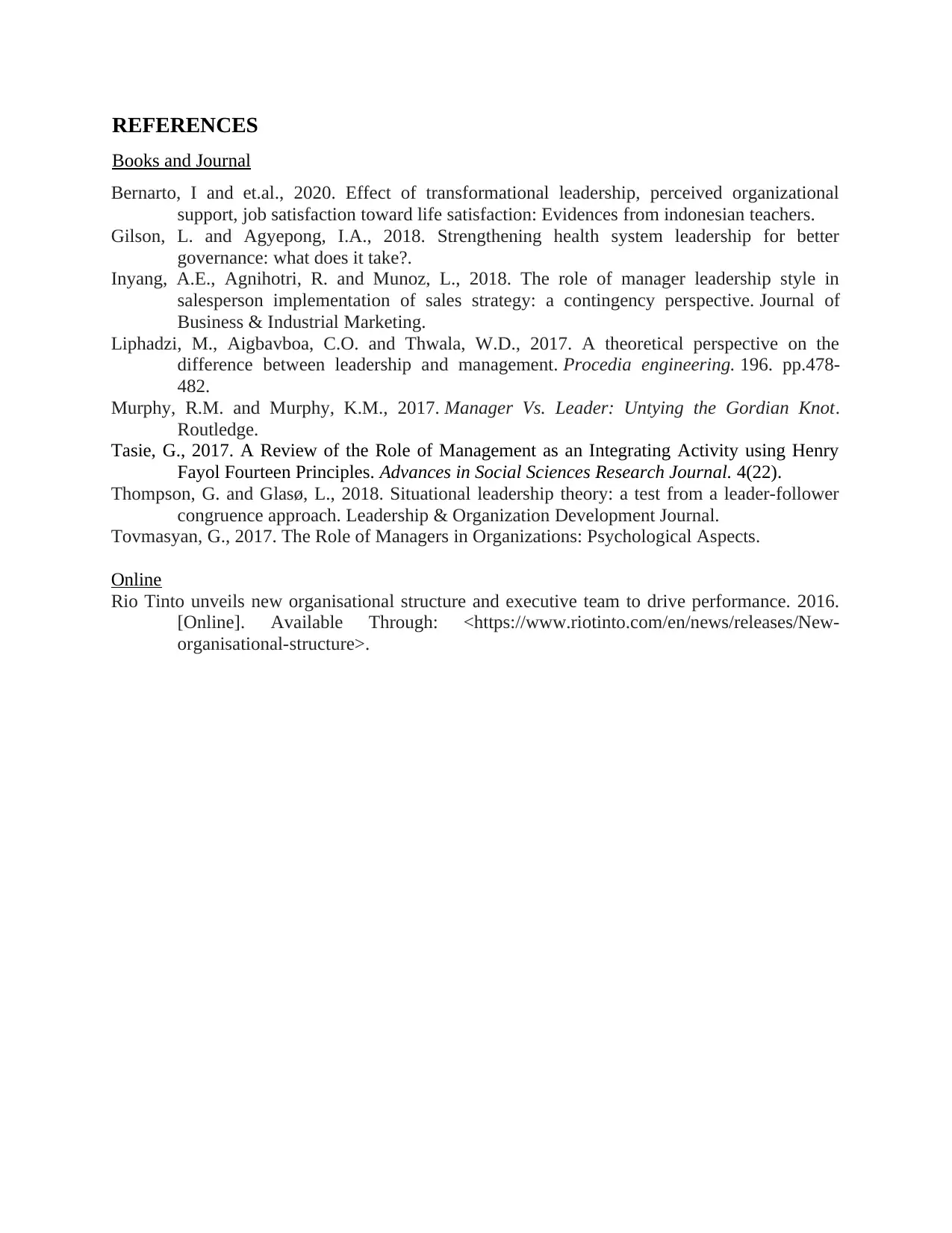
REFERENCES
Books and Journal
Bernarto, I and et.al., 2020. Effect of transformational leadership, perceived organizational
support, job satisfaction toward life satisfaction: Evidences from indonesian teachers.
Gilson, L. and Agyepong, I.A., 2018. Strengthening health system leadership for better
governance: what does it take?.
Inyang, A.E., Agnihotri, R. and Munoz, L., 2018. The role of manager leadership style in
salesperson implementation of sales strategy: a contingency perspective. Journal of
Business & Industrial Marketing.
Liphadzi, M., Aigbavboa, C.O. and Thwala, W.D., 2017. A theoretical perspective on the
difference between leadership and management. Procedia engineering. 196. pp.478-
482.
Murphy, R.M. and Murphy, K.M., 2017. Manager Vs. Leader: Untying the Gordian Knot.
Routledge.
Tasie, G., 2017. A Review of the Role of Management as an Integrating Activity using Henry
Fayol Fourteen Principles. Advances in Social Sciences Research Journal. 4(22).
Thompson, G. and Glasø, L., 2018. Situational leadership theory: a test from a leader-follower
congruence approach. Leadership & Organization Development Journal.
Tovmasyan, G., 2017. The Role of Managers in Organizations: Psychological Aspects.
Online
Rio Tinto unveils new organisational structure and executive team to drive performance. 2016.
[Online]. Available Through: <https://www.riotinto.com/en/news/releases/New-
organisational-structure>.
Books and Journal
Bernarto, I and et.al., 2020. Effect of transformational leadership, perceived organizational
support, job satisfaction toward life satisfaction: Evidences from indonesian teachers.
Gilson, L. and Agyepong, I.A., 2018. Strengthening health system leadership for better
governance: what does it take?.
Inyang, A.E., Agnihotri, R. and Munoz, L., 2018. The role of manager leadership style in
salesperson implementation of sales strategy: a contingency perspective. Journal of
Business & Industrial Marketing.
Liphadzi, M., Aigbavboa, C.O. and Thwala, W.D., 2017. A theoretical perspective on the
difference between leadership and management. Procedia engineering. 196. pp.478-
482.
Murphy, R.M. and Murphy, K.M., 2017. Manager Vs. Leader: Untying the Gordian Knot.
Routledge.
Tasie, G., 2017. A Review of the Role of Management as an Integrating Activity using Henry
Fayol Fourteen Principles. Advances in Social Sciences Research Journal. 4(22).
Thompson, G. and Glasø, L., 2018. Situational leadership theory: a test from a leader-follower
congruence approach. Leadership & Organization Development Journal.
Tovmasyan, G., 2017. The Role of Managers in Organizations: Psychological Aspects.
Online
Rio Tinto unveils new organisational structure and executive team to drive performance. 2016.
[Online]. Available Through: <https://www.riotinto.com/en/news/releases/New-
organisational-structure>.
⊘ This is a preview!⊘
Do you want full access?
Subscribe today to unlock all pages.

Trusted by 1+ million students worldwide
1 out of 9
Related Documents
Your All-in-One AI-Powered Toolkit for Academic Success.
+13062052269
info@desklib.com
Available 24*7 on WhatsApp / Email
![[object Object]](/_next/static/media/star-bottom.7253800d.svg)
Unlock your academic potential
Copyright © 2020–2025 A2Z Services. All Rights Reserved. Developed and managed by ZUCOL.





